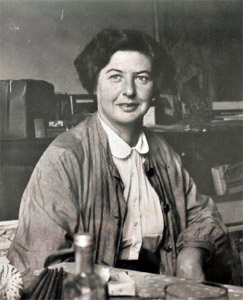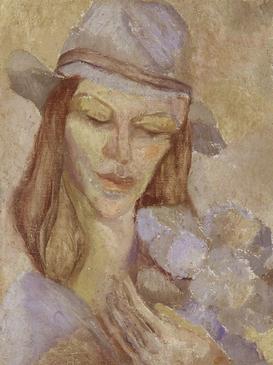Moya Dyring facts for kids
Quick facts for kids
Moya Dyring
|
|
|---|---|
 |
|
| Born | 10 February 1909 Coburg, Australia
|
| Died | 4 January 1967 (aged 57) London, United Kingdom
|
| Nationality | Australian |
| Education | National Gallery of Victoria Art School |
| Known for | Painting |
| Movement | Cubism |
| Spouse(s) | Sam Atyeo (married 1941–1948) |
Moya Dyring (born February 10, 1909 – died January 4, 1967) was an Australian artist. She was one of the first women in Australia to create and show modern art. This included paintings in the Cubist style, which uses geometric shapes.
For some years, Moya was part of a group of modern artists called the Heide Circle. This group met at the home of art collectors John and Sunday Reed. Their home is now the Heide Museum of Modern Art. Later, Moya traveled to the USA and France. She lived in France for most of her life. Her art can be seen at the Heide Museum and the National Gallery of Australia.
Contents
Early Life and Art School
Moya Clare Dyring was born in Coburg, Victoria, Australia, in 1909. She was the third child in her family. Her father, Carl Peter Wilhelm Dyring, was a doctor. Her mother was Dagmar Alexandra Esther.
In 1920, Moya's family moved to Brighton, a suburb of Melbourne. Moya went to Firbank Church of England Girls' Grammar School from 1917 to 1927.
Studying Art in Melbourne
After visiting Paris in 1928, Moya decided to study art. From 1929 to 1932, she attended the National Gallery of Victoria Art School (NGV) in Melbourne. There, she met Sam Atyeo, who would later become her husband. He was also an artist and lived in Paris.
After NGV, Moya continued her studies with George Bell. She learned at his Bourke Street Studio School in Melbourne. Both George Bell and Sam Atyeo encouraged Moya to try new, modern styles of art. Sunday Reed, who became a close friend, also studied at Bell's school.
Her Art Career
In 1937, Moya looked after Heide, the home of art collectors John and Sunday Reed. This home was in Bulleen, near Melbourne. Moya became a key part of the artist group that gathered at Heide. This group was known as the Heide Circle. She became very good friends with Sunday Reed and another artist named Joy Hester. We know a lot about Moya's life from the many letters she wrote to Sunday Reed over the years.
First Art Shows
Moya had a very successful art show in Melbourne in June 1937. It was held at the Riddell Gallery. John and Sunday Reed bought one of her paintings from this show.
In August 1937, Moya traveled overseas. She first went to Panama, then to New York City. She did not like the art she saw in America. So, she sailed to France.
Life and Art in Paris
By 1938, Moya was living in Paris, France. She used Sam Atyeo's connections to meet other modern artists. She studied at famous art schools like the Académie Colarossi and the Académie de la Grande Chaumière. She also learned from the artist André Lhote.
In 1939, Moya and Sam Atyeo moved to a farm in Vence, France. Later, Sam went to work in Dominica, in the West Indies. Moya stayed in Vence. When World War II started, she had to return to Australia. She traveled through South Africa, where she painted and studied local tribal art.
From Australia, Moya went to Dominica and married Sam Atyeo. Sam then got a job in the USA, and Moya joined him there. However, they were not happy, and neither of them painted much. In 1946, Moya returned to Paris alone. They divorced in 1950.
Chez Moya
In Paris, Moya set up an apartment. She often welcomed Australian artists and friends who were visiting. Her apartment became famous as Chez Moya.
In 1961, Moya helped choose the Australian art for the Paris Biennale. This is a big art exhibition. She returned to Australia five times until 1963. On each visit, she showed her art in different cities.
Moya stayed in touch with the Reeds until she died from cancer in 1967. She passed away in Wimbledon, London. After her death, her friends bought an art studio in Paris. The Art Gallery of New South Wales now lets Australian artists use this studio for two months each year.
Her Artworks
Moya Dyring created many drawings, oil paintings, and pastels.
One of her first Cubist-style works was Melanctha from 1934. Sunday Reed bought this painting. In the same year, 1934, Moya also painted Portrait of Sunday Reed. This painting, along with a Cubist Portrait of a Woman, also became part of the Reeds' art collection.
At first, her art showed people or used Cubist shapes. But in France, she started painting landscapes as she traveled around the country. In her later years, when she could not travel easily, she painted children with Paris as the background.
For a long time, Moya's work was not often included in major art shows. Especially shows about women artists from the 1930s, 40s, and 50s. But in 2002, a student named Gaynor Patricia Cuthbert wrote a special paper about Moya's life and art. This helped bring attention back to her important work.
Art Collections
The Heide Museum of Modern Art has many of Moya Dyring's paintings and drawings. Some of these were from the collection of John and Sunday Reed.
The National Gallery of Australia in Canberra has one of her drawings.
The Art Gallery of New South Wales holds several of her artworks.
You can often see images of Moya Dyring's works on the websites of these art galleries.
Tribute
A street in Canberra is named after Moya Dyring. It is called Dyring Place and is in the suburb of Chisholm.
Images for kids
See also
 In Spanish: Moya Dyring para niños
In Spanish: Moya Dyring para niños



